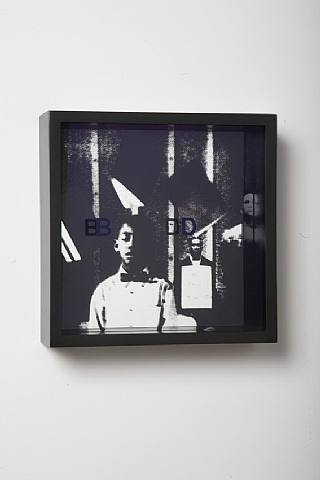
For the past two winters I have had the privilege of curating the SEGUE reading series, last winter with Evelyn Reilly, this winter with Sara Wintz. SEGUE has featured innovative writing since the 70s when the series was held at the Ear Inn bar in TriBeCa. Originally identified with Language Writing, SEGUE features a diverse range of socially and politically committed writing and performance practices. It is currently housed at the Bowery Poetry Club in Manhattan.
The following is an introduction I read for the visual artist Adam Pendleton this evening at SEGUE. For me, introductions are a way to focus an audience's attention before they hear a reading, warming them up for what they are about to hear. In my introductions I tend to provide contextualizing information about the person I am introducing, but also try to 'say' something about their work. Which is to say, attempt to access some kernel about the writer's work/project/person.
Next week's SEGUE reading will feature current Harriet blogger Fred Moten, and poet/translator/editor Mónica de la Torre. For those who will be in town next Saturday please join us!
My first encounter with Adam Pendleton’s work was in the fall of 2007 during the Performa live arts biennial. Pendleton, among a handful of other artists including Yvonne Rainer and Isaac Julian, had been commissioned to create a performance-based work. What he produced—entitled The Revival—was extravagant to say the least: a full on gospel choir with four-piece band and Pendleton playing preacher, parrying with the best of them. What was unique to me about Pendleton’s revival was foremost its negotiation of sincere modes of address with ironic ones, and of avant poetries (John Ashbery, Leslie Scalapino, Paolo Javier) with autobiographical writings by Gay health activists. As Pendleton explains in an interview with Jess Wilcox, The Revival presented a means of addressing appropriation strategies in art via non-mastery, a function of appropriation that would not only recognize what one already knows—the trap of anagnorisis—but also make available new pathways for inquiry and experience. As Pendleton states in the 2009 interview with Wilcox in Art in America:
In no way am I a master of the revivalist form and have no desire to be. I question the power and energy of speech - perhaps ironically so. I understand the particular cultural potential of specific forms and appropriate them -- but more importantly, I bring them into an experimental space. In many ways, appropriation is nothing more than offering back what we know. I don't dramatize this process. Yet, it is clearly a kind of possession-possession. Mastery and things like the energy and power of speech are just a way of articulating the recognition of an element of something we are culturally familiar with, or aware of. That's why experimental spaces are so important. At their best, they move beyond these known quantities.
Given the many ambivalences of The Revival, Pendleton’s practice makes me wonder about the stakes of art post identity politics and, furthermore, post identity. It also presents a radical case for why experimentation in the arts, and I would argue within a culture at large, is a kind of good unto itself inasmuch as it overturns the categorical logics which we are prone to impose on the world and the world on us. Through experimentation, Pendleton embraces an avant garde tradition without guarantee; which is to say, he embraces such a tradition on his own terms, renewing what it means to be committed to experimental and/or avant garde identified cultural practices.
That Pendleton’s recent solo-exhibition "EL T D K" pays tribute to Amiri Baraka’s 1964 poem “Black Dada Nihilismus” seems a perfectly logical step in Pendleton’s practice. Listening to Baraka read his poem tonight repeatedly at PennSound, from a 1964 reading at the Asilomar Negro Writers Conference in Pacific Grove, California, I could hear in Baraka’s reading echoes of the ambivalence that Pendleton himself brings to the performance of his work—an ever-shifting blend of irony and sincerity, affirmation and negation, caveat and invitation. Through his identification with a white, European avant garde movement—Dada—Baraka gives voice to a genealogy of violent struggle against a society of white masters. Given the content of Pendleton’s exhibition—a set of paintings with only phonemes painted on them, a long row of boxy lithographs reproducing widely known photo-documents from canonical 60s and 70s art performances, and a Sol LeWitt-like installation of black cubes entitled “Black Dada”—like Baraka before him Pendleton would seem to recover a white-identified art tradition for Black and Gay liberation struggles while calling into question the perceived reduction such reappropriative gestures can perform.
If Pendleton’s photographic reproductions impose representational history upon its viewer—the representational history of a canonized avant garde—the words and proto-words that Pendleton paints upon the photographic images efface the representational content of such an archive while simultaneously preserving it (a kind of duck rabbit of non-representational ‘word’ and representational ‘image’). In the same interview Pendleton writes: “I am working to establish a system of display, of organization. I want to create a situation where we're inclined to rethink notions of the past and the future, as well as our ability to understand them enough to make reductive statements.” I like that in Pendleton’s work the future and the past are up for grabs, and the predominant site of their contested meaning remains “language”—the language of images and words which, as Pendleton reminds us, “can also determine thought.”
Thom Donovan lives in New York City where he edits Wild Horses of Fire weblog (whof.blogspot.com) and...
Read Full Biography

